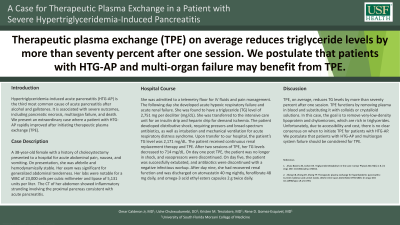Back


Poster Session D - Tuesday Morning
Category: Biliary/Pancreas
D0029 - A Case for Therapeutic Plasma Exchange in a Patient With Severe Hypertriglyceridemia-Induced Pancreatitis
Tuesday, October 25, 2022
10:00 AM – 12:00 PM ET
Location: Crown Ballroom

Has Audio

Omar Calderon, Jr., MD
University of South Florida
Tampa, FL
Presenting Author(s)
Omar Calderon, MD1, Uche Chukwudumebi, DO1, Kristen M. Tessiatore, MD1, Rene D. Gomez-Esquivel, MD2
1University of South Florida, Tampa, FL; 2USF Health Morsani College of Medicine, Tampa, FL
Introduction: Hypertriglyceridemia-induced acute pancreatitis (HTG-AP) is the third most common cause of acute pancreatitis after alcohol and gallstones. It is associated with severe outcomes, including pancreatic necrosis, multiorgan failure, and death. We present an extraordinary case where a patient with HTG-AP rapidly improved after initiating therapeutic plasma exchange (TPE).
Case Description/Methods: A 38-year-old female with a history of cholecystectomy presented to a hospital for acute abdominal pain, nausea, and vomiting. On presentation, she was afebrile and hemodynamically stable. Her exam was significant for generalized abdominal tenderness. Her labs were notable for a WBC of 23,000 cells per cubic millimeter and lipase of 5,131 units per liter. The CT of her abdomen showed inflammatory stranding involving the proximal pancreas consistent with acute pancreatitis. She was admitted to a telemetry floor for IV fluids and pain management. The following day she developed acute hypoxic respiratory failure and acute renal failure. She was found to have a triglyceride (TG) level of 2,751 mg per deciliter (mg/dL). She was transferred to the intensive care unit for an insulin drip and heparin drip for demand ischemia. The patient developed distributive shock, requiring pressors and broad-spectrum antibiotics, as well as intubation and mechanical ventilation for acute respiratory distress syndrome. Upon transfer to our hospital, the patient’s TG level was 2,171 mg/dL. The patient received continuous renal replacement therapy and TPE. After two sessions of TPE, her TG levels decreased to 714 mg/dL. On day one post TPE, the patient was no longer in shock, and vasopressors were discontinued. On day five, the patient was successfully extubated, and antibiotics were discontinued with a negative infectious workup. After day nine, she had recovered renal function and was discharged on atorvastatin 40 mg qHS, fenofibrate 48 mg QD, and omega-3 acid ethyl esters capsules 2 g BID.
Discussion: TPE, on average, reduces TG levels by more than seventy percent after one session. TPE functions by removing plasma in blood and substituting it with colloids or crystalloid solutions. In this case, the goal is to remove very-low-density lipoprotein and chylomicrons, which are rich in triglycerides. Unfortunately, due to accessibility and cost, there is no clear consensus on when to initiate TPE for patients with HTG-AP. We postulate that patients with HTG-AP and multiorgan system failure should be considered for TPE.
Disclosures:
Omar Calderon, MD1, Uche Chukwudumebi, DO1, Kristen M. Tessiatore, MD1, Rene D. Gomez-Esquivel, MD2. D0029 - A Case for Therapeutic Plasma Exchange in a Patient With Severe Hypertriglyceridemia-Induced Pancreatitis, ACG 2022 Annual Scientific Meeting Abstracts. Charlotte, NC: American College of Gastroenterology.
1University of South Florida, Tampa, FL; 2USF Health Morsani College of Medicine, Tampa, FL
Introduction: Hypertriglyceridemia-induced acute pancreatitis (HTG-AP) is the third most common cause of acute pancreatitis after alcohol and gallstones. It is associated with severe outcomes, including pancreatic necrosis, multiorgan failure, and death. We present an extraordinary case where a patient with HTG-AP rapidly improved after initiating therapeutic plasma exchange (TPE).
Case Description/Methods: A 38-year-old female with a history of cholecystectomy presented to a hospital for acute abdominal pain, nausea, and vomiting. On presentation, she was afebrile and hemodynamically stable. Her exam was significant for generalized abdominal tenderness. Her labs were notable for a WBC of 23,000 cells per cubic millimeter and lipase of 5,131 units per liter. The CT of her abdomen showed inflammatory stranding involving the proximal pancreas consistent with acute pancreatitis. She was admitted to a telemetry floor for IV fluids and pain management. The following day she developed acute hypoxic respiratory failure and acute renal failure. She was found to have a triglyceride (TG) level of 2,751 mg per deciliter (mg/dL). She was transferred to the intensive care unit for an insulin drip and heparin drip for demand ischemia. The patient developed distributive shock, requiring pressors and broad-spectrum antibiotics, as well as intubation and mechanical ventilation for acute respiratory distress syndrome. Upon transfer to our hospital, the patient’s TG level was 2,171 mg/dL. The patient received continuous renal replacement therapy and TPE. After two sessions of TPE, her TG levels decreased to 714 mg/dL. On day one post TPE, the patient was no longer in shock, and vasopressors were discontinued. On day five, the patient was successfully extubated, and antibiotics were discontinued with a negative infectious workup. After day nine, she had recovered renal function and was discharged on atorvastatin 40 mg qHS, fenofibrate 48 mg QD, and omega-3 acid ethyl esters capsules 2 g BID.
Discussion: TPE, on average, reduces TG levels by more than seventy percent after one session. TPE functions by removing plasma in blood and substituting it with colloids or crystalloid solutions. In this case, the goal is to remove very-low-density lipoprotein and chylomicrons, which are rich in triglycerides. Unfortunately, due to accessibility and cost, there is no clear consensus on when to initiate TPE for patients with HTG-AP. We postulate that patients with HTG-AP and multiorgan system failure should be considered for TPE.
Disclosures:
Omar Calderon indicated no relevant financial relationships.
Uche Chukwudumebi indicated no relevant financial relationships.
Kristen Tessiatore indicated no relevant financial relationships.
Rene Gomez-Esquivel indicated no relevant financial relationships.
Omar Calderon, MD1, Uche Chukwudumebi, DO1, Kristen M. Tessiatore, MD1, Rene D. Gomez-Esquivel, MD2. D0029 - A Case for Therapeutic Plasma Exchange in a Patient With Severe Hypertriglyceridemia-Induced Pancreatitis, ACG 2022 Annual Scientific Meeting Abstracts. Charlotte, NC: American College of Gastroenterology.
